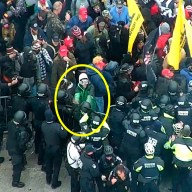You don’t ask Robert Zemeckis about themes and ideas. What the filmmaker — of “Back to the Future,” “Who Framed Roger Rabbit,” “Forrest Gump” and now “The Walk” — most likes to talk about is the technical side. (J. Hoberman has said the filmmaker was even oblivious to the Oedipal subtext — really, the text — in “Back to the Future.”) He was an early embracer of digital effects and hot new technologies, and even dramas like “Flight” tend to feature extensive use of subtle CGI. Still, he maintains that he doesn’t do films to do tech; it’s the stories that grab him, with digital effects employed as a tool to flesh them out. With “The Walk,” he tells a story already told in the acclaimed doc “Man on Wire”: how French acrobat Philippe Petit (played by Joseph Gordon-Levitt) covertly strung a tight-rope between the Twin Towers in 1974 and strolled across them. But he marshals the forces of first-rate tech to put us up there with him as he struts 110 stories above the ground. Like “Flight,” this is a live-action film reliant on sometimes subtle, sometimes not-so-subtle CGI. Could you even make “The Walk” without relying on CGI?
I don’t even know how you’d do it at all. I guess you could use miniatures. Back in the old days you’d use miniatures and process screens. It certainly would have been very limiting.
Some of the CGI in this film is about recreating things that no longer exist. You create the World Trade Center both from the outside and the inside. In the past they would just build a set. This seems…well, not cheaper… Just because it’s digital doesn’t mean it costs nothing. You have to understand that. People can say things like, “Oh, a microphone dropped into the shot, screw it, move on, we’ll paint it out later.” Well, that costs money. Or, “Oh, gee, I made a mistake on the color of the actor’s tie. I’m going to change it from red to green.” To do that in every shot costs money. Filmmakers have to be careful that they don’t get sloppy, figuring they can change everything — which they can. But it costs money. To answer your question, basically you build what you need. So you build what the actors are going to touch, and you do a set extension. Sometimes it’s cheaper to build more stuff, sometimes it’s cheaper to build stuff virtually. It’s always a trade-off. Obviously it’s more difficult and more expensive to create photo-realistic reality. Doing s— in outer space, nobody knows what it looks like. Aliens, anybody can do aliens, because nobody knows what they look like. It’s hard to do humans. RELATED: “The Walk,” another Philippe Petit film, is both redundant and transcendent The big walk at the end is obviously very effects-heavy, but even in the dramatic scenes, such as in Paris or on the streets of 1970s New York, there’s a lot of digital manipulation.
We shot Paris in Montreal, so in some shots all we used were the cobblestones on the street. Everything else was painted in. Digital cinema is magnificent. You can do so many great things. It’s a great tool. One of the things I love is I can shoot at a high-frame rate, and then I can adjust the speed of the camera movement. Or if an actor moves his head to react a little bit too quick, I can subtly slow it down and give it a more dramatic move that the audience can’t perceive. Sometimes an actor will have a little twitch or an eye blink at the most inopportune moment in his performance. You can change the actor’s makeup. If he has circles under his eyes you can just paint them out. How is that for the actors, knowing their work can be manipulated?
Most actors probably aren’t aware of all the sophistication of the tools we have. But some do. I think acting is going to evolve, as with all technology. Actors in the early days of cinema had to project their voices because the microphones weren’t that sensitive. Now actors can whisper or mumble their performances so we can pick up what they’re saying. Actors will evolve knowing that digital tools can help them enhance their performances as time goes on. Originally you were going to do this as a motion-capture film, right?
I thought of it, yeah. I had this idea that I would have the real Philippe do the walk, because he would do it exactly how he did it. I would build an avatar of his body and make him younger. Then I realized it’s probably better just to do it as a live-action movie with all these digital enhancements. The early days of motion-capture were sometimes criticized as being too larval.
It’s only a matter of years before it’s completely seamless. We’re on the cusp of it. We have a lot of performance capture in “The Walk,” but nobody can see it.
Have you seen “The Congress,” the Ari Folman film with Robin Wright?
I haven’t.
In it, Wright plays a version of herself whose body is scanned into a computer, so filmmakers can make movies with her eternally younger self while she ages. They just plug her likeness into movies and create human performances entirely with computers. That is exactly what’s going to happen. But think about how cool that would be. Think about how cool if you had a really great screenplay, and it’s a saga where a character has to age from a young man in his 20s to being in his 70s. You could get someone like Jack Nicholson to play that. He would do his performance as his 20-year-old self, and you would create his body digitally, the way he looked in “Easy Rider.” Then he can also himself the way he looks now. That would be really cool. You wouldn’t have to do the thing of having two actors. Is that something you’d like to do at some point?
I don’t have a story. I don’t know. I’m not searching for one. If a story presented itself, that would be a cool way to do it.
So you’re always about the story before the technology with which you can tell it.
Always. Always.
RELATED: “The Martian” is a rare fell-good Ridley Scott movie (about potential death) This is another of your 3-D movies, but it’s different from, say, “The Polar Express” or “Beowulf” because, apart from the walk itself, most of it is a drama. Wim Wenders has talked about how more non-spectacles, even art house films, should use 3-D. 3-D is a format and a tool, but it always needs to be organic to the story you’re telling. 3-D is cool if it’s enhancing the experience. If you had a movie like, say, one that takes place on a roller coaster — like a runaway roller coaster that never stops, and there’s some crazy drama that’s going on. That would be a cool movie to do in 3-D. If that same drama took place in a closet, and that was the whole point of the story, 3-D would probably not enhance the experience. I don’t think “My Dinner with Andre” would be a great movie in 3-D. That’s a call you make. It’s like deciding if you’re going to make a movie in black-and-white or in color, or if you’re going to make a movie widescreen or spherical. Then you have to make the whole movie like you’re making the movie in 3-D. You have to have pay attention everything. You have to ask yourself, “Is this going to work? Is that camera panning too much? Is it moving too fast?” A movie like “Flight,” I would never think of it making it in 3-D. It doesn’t belong in 3-D. Though the opening crash could have been a neat 3-D experience.
But the crash, 50 percent of the images are just close-ups of instruments on an instrument panel. It’s just cutting to warning lights and stuff.
Can you talk about how you handled portraying the World Trade Center? Right after the attacks there was a movement to erase images of it. The climax of “Spider-Man” was reshot because it took place there. Older films that prominently featured the Twin Towers were considered, for a time, verboten. But in “The Walk,” in 2015, you get to show it and it no longer feels like an affront. I don’t know why they would have removed the World Trade Center, because that becomes a historical document, which is vital and important. That’s the way I approached this. The movie took place in 1974, the Twin Towers were there. The memory of the World Trade towers is very tragic, but there are also things that happened there that are beautiful, like what Philippe did. So it’s like anything that doesn’t exist anymore. You can’t only remember it for the dark things. You have to remember it for everything.
Robert Zemeckis on the amazing technology behind ‘The Walk’
Follow Matt Prigge on Twitter @mattprigge


















